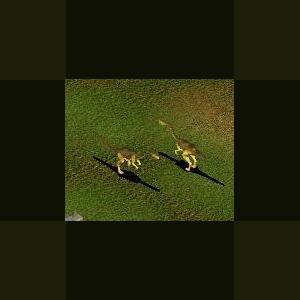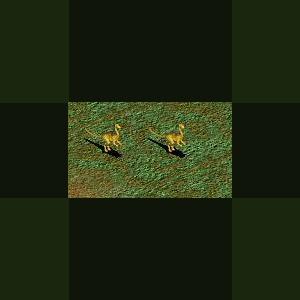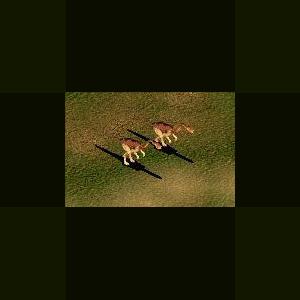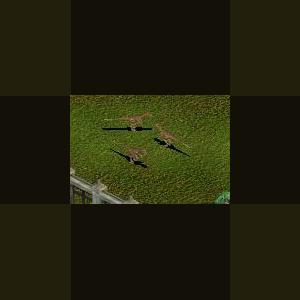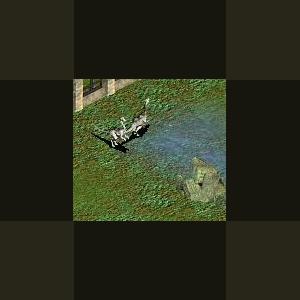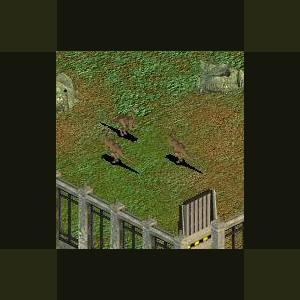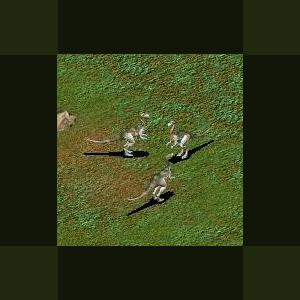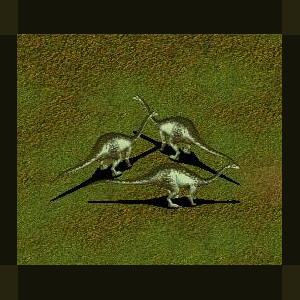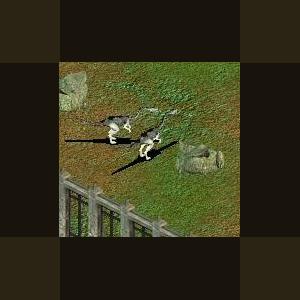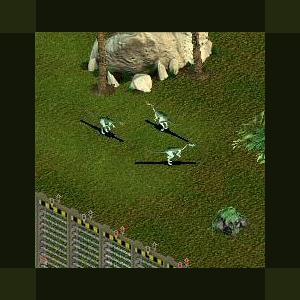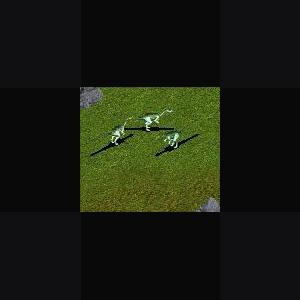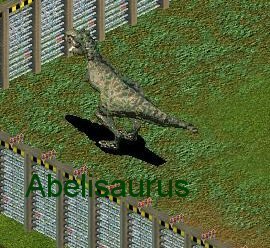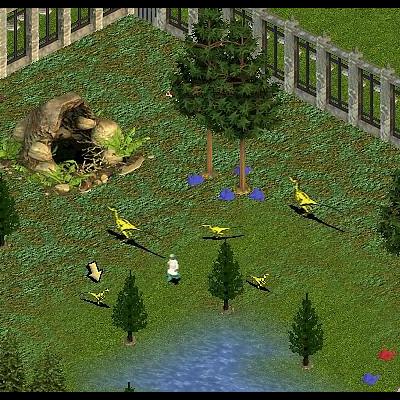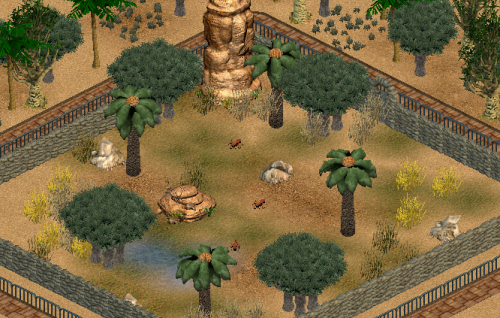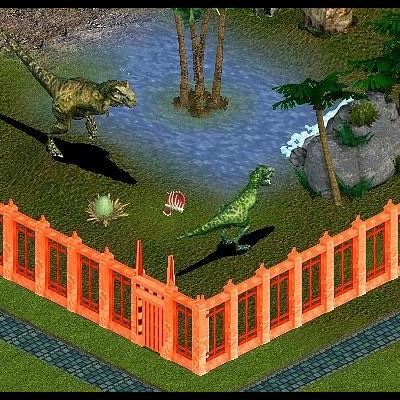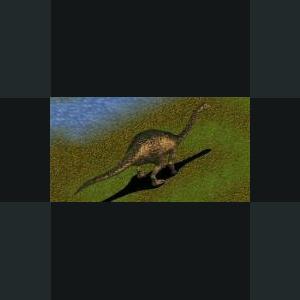Dinosaurs
Creatures from another age
241 files
-
Eucoelophysis by Moondawg
By Guest
Eucoelophysis
Eucoelophysis (meaning "true hollow tail") is a genus of dinosauriform from the Late Triassic period of North America. It was assumed to be a coelophysid upon description, but a 2005 study by Nesbitt et al. found that it was actually a close relative of Silesaurus, which was independently supported by Ezcurra (2006), who found it to be the sister group to Dinosauria, and Silesaurus as the next most basal taxon.
However, the relationships of Silesaurus are uncertain. Dzik found it to be a dinosauriform (the group of archosaurs from which the dinosaurs evolved), but did not rule out the possibility that it represents a primitive ornithischian.
125 downloads
0 comments
Updated
-
Oryctodromeus by Moondawg
By Guest
Oryctodromeus
Oryctodromeus (meaning "digging runner") was a genus of small ornithopod dinosaur, the fossilized remains of which have been found in rocks dating from the middle Cretaceous Blackleaf Formation of southwestern Montana (Cenomanian stage), roughly 95 million years ago. A member of the small, presumably fast-running herbivorous family Hypsilophodontidae, Oryctodromeus is the first dinosaur published that shows evidence of burrowing behavior.
Oryctodromeus is based on MOR 1636a, a partial skeleton of an adult individual including: the premaxillae (upper beak); part of the braincase; three neck, six back, seven hip, and twenty-three tail vertebrae; ribs; the shoulder girdle; an arm (minus the hand); both tibiae and an incomplete fibula; and a metatarsal. Two additional individuals, both juveniles about 55 to 65% the size of MOR 1636a, are represented by MOR 1636b. Unlike many other ornithopod dinosaurs, Oryctodromeus lacked bony tendons that stiffened the tail, which would have made moving about inside a small burrow easier. Additionally, it shows adaptations in the jaws, forelimbs, and pelvis that could have helped move and manipulate soil.
The authors pointed out that Oryctodromeus had only modest forelimb modifications in comparison to dedicated burrowing animals, like moles, echidnas, and wombats. Instead, it was comparable to, but somewhat more specialized for digging than animals that both run and burrow today, like aardwolves, cavies, hyenas, and rabbits. Because it was a biped, it could have a more modified forelimb without affecting its ability to run.
Under a cladistic analysis, Oryctodromeus was found to be basal within Euornithopoda and a close relative of the hypsilophodonts Orodromeus and Zephyrosaurus, which are also known from the Cretaceous of Montana. These two animals share adaptations with Oryctodromeus that may have been used for burrowing, such as a broad snout. Additionally, Orodromeus specimens have been found preserved in a similar way, suggesting that they too were in burrows. This would not be the first time that a hypsilophodont has been suggested as a burrower; Robert Bakker has informally claimed since the 1990s that Drinker, from the late Jurassic of Wyoming, lived in burrows, but this has yet to be published.
The three Oryctodromeus individuals were found buried within the remains of an underground den or burrow, measuring about 2 meters long (6.5 feet) and 70 centimeters wide (2.3 ft). The skeletons were densely packed and disarticulated, indicating that the animals died and decayed within the burrow. The burrow is similar to those made by hyenas and puffins today. It was filled with sand, and the resulting sandstone stands out against the surrounding mudstone and claystone.
There are two turns in the preserved burrow section, and smaller secondary sandstone cylinders of various sizes (a few centimeters or inches in cross-section at most) that were probably made by smaller animals sharing the burrow (commensal). The burrow closely fits the probable proportions of the adult dinosaur, another indication that it was the digger.
As a hypsilophodont, Oryctodromeus would have been a small, swift herbivore. This aspect, coupled with where it was discovered, gives it its name: Oryctodromeus cubicularis translates as "digging runner of the lair", in reference to its presumed lifestyle. The adult Oryctodromeus itself measured 2.1 m long (6.8 ft) and would have weighed about 22-32 kilograms (50-70 pounds), and the juveniles would have been about 1.3 m long (4.3 ft). The presence of juveniles with the adult suggests parental care, and that at least one motivation for burrowing was to rear the juveniles. The size of the juveniles suggests an extended period of parental care.
124 downloads
0 comments
Updated
-
Shuvosaurus by Moondawg
By Guest
Shuvosaurus
Shuvosaurus (meaning "Shuvo's lizard") is a beaked reptile from the Late Triassic of Texas. It was described by Sankar Chatterjee in 1993 after it was discovered by his son Shuvo. It was initially interpreted as a Triassic member of the Cretaceous dinosaur family Ornithomimidae. However, the recent discovery of the related Effigia from Ghost Ranch shows that Shuvosaurus is more closely related to crocodilians, and that similarities between this animal and ornithomimids result from convergent evolution. Additionally, this discovery demonstrated that the taxon Chatterjeea was synonymous with Shuvosaurus.
123 downloads
0 comments
Updated
-
Lycorhinus by Moondawg
By Guest
Lycorhinus angustidens is a heterodontosaurid ornithischian dinosaur hailing from the Early Jurassic strata of the Eliot Formation located in the Cape Province, South Africa.
The fossil remains consist in dentaries and maxillae hence the name that Haughton gave them in 1924, where the generic name means “wolf snout”, as it was at first misidentified as a cynodont, and the specific epithet means “constricted teeth”. Lycorhinus, including the remains described by Gow in 1975 as Lanasaurus, is a small herbivore dinosaur despite long canines it sported in its jaws; due to this unique characteristic L. angustidens is very clearly allied to Heterodontosaurus.
122 downloads
0 comments
Updated
-
Timimus by Moondawg
By Guest
Timimus was a small coelurosaurian theropod, which may have been an ornithomimosaurid. The name "Tim's Mimic" was coined by the discoverers' son Tim and for Tim Flannery.
The type species, Timimus hermani, was formally described by Dr Thomas Rich and Patricia Vickers-Rich in 1993, after two femora (thigh bones), one from an adult and one from a juvenile, were found within a metre of each other. Some vertebrae have also been attributed to this species.
In 1994 Dr Rich reported that while it was ideal to have the most complete specimen possible as a holotype, it was highly unlikely that future material of Timimus would be found, due to the limited nature of sites to be explored in the area. Also, the holotype had characteristics which both identified it as an ornithomimosaur and a new genus within that group. Thus the name would serve as a reference point for the material within paleontological literature.
Inspired by the Zoo Tek Brains Trust
121 downloads
0 comments
Updated
-
Pisanosaurus by Moondawg
By Guest
Pisanosaurus
Pisanosaurus mertii (the name comes from "Pisano", who was an associate of the finder, and "saurus" meaning lizard or reptile) is a primitive bipedal Ornithischian dinosaur from the Late Triassic.
Pisanosaurus was 3.2 feet (1 meter) in length and 12 inches (30.48 centimeters) in height. Its weight estimate is just under 8.8 pounds (four kilograms). These estimates vary due to the incompleteness of the fossil.
Pisanosaurus is known from a fragmented skeleton found in Argentina. It is very basal within Ornithischia; the postcrania seem to lack any good ornithischian synapomorphy; it has even been suggested the fossil is a chimera.
Pisanosaurus (meaning "Pisano lizard") is a genus of primitive ornithischian dinosaur from the Late Triassic of what is now South America. It was a bipedal herbivore described by Argentine paleontologist Rodolfo Casamiquela in 1967. Only one species, the type, Pisanosaurus mertii, is known, based on one partially complete skeleton. The fossils were discovered in Argentina's Late Triassic Ischigualasto Formation, from around 228 to 216.5 million years ago.
The exact classification of Pisanosaurus has been the topic of debate by scientists for over 40 years; the current consensus is that Pisanosaurus is the oldest known ornithischian, part of a diverse group of dinosaurs which lived during nearly the entire span of the Mesozoic Era.
Based on the known fossil elements, Pisanosaurus was a small, lightly-built dinosaur approximately 1 m (3 ft 3 in) in length and 30 cm (12 in) in height. Its weight was between 2.27–9.1 kg (5–20 lb). These estimates vary due to the incompleteness of the fossil. The tail of Pisanosaurus has been reconstructed as being as long as the rest of the body, based on other early ornithischians, but as a tail has not been recovered, this is speculative. It was bipedal and, like all ornithischians, was probably exclusively herbivorous.
Pisanosaurus mertii was described by Argentine paleontologist Rodolfo Casamiquela in 1967. The name Pisanosaurus honors Juan A. Pisano, an Argentine paleontologist, while saurus is derived from the Greek sa????, meaning "lizard". Pisanosaurus is known from a single fragmented skeleton found in Argentina. It is based on a specimen given the designation PVL 2577, which was discovered in the Ischigualasto Formation.
The fossils of Pisanosaurus were discovered in Argentina's Ischigualasto Formation. Originally dated to the Middle Triassic, this formation is now believed to belong to the Late Triassic Carnian stage, around 228 to 216.5 million years ago. Pisanosaurus shared its habitat with rhynchosaurs, cynodonts, dicynodonts, prestosuchids, ornithosuchids, aetosaurs, and primitive dinosaurs. The early carnivorous dinosaur Herrerasaurus lived in this area and at this time, and may have fed upon Pisanosaurus.
121 downloads
0 comments
Updated
-
Parksosaurus by Moondawg
By Guest
Parksosaurus
Parksosaurus ("William Parks's lizard") was a genus of hypsilophodont ornithopod dinosaur from the early Maastrichtian-age Upper Cretaceous Horseshoe Canyon Formation of Alberta, Canada. It is based on most of a partially articulated skeleton and partial skull, showing it to have been a small, bipedal, herbivorous dinosaur. It is one of the few described non-hadrosaurid ornithopods from the end of the Cretaceous in North America, existing around 70 million years ago.
Explicit estimates of the entire size of the animal have not been done, but William Parks found the hindlimb of his T. warreni to be about the same length overall as that of Thescelosaurus neglectus (93.0 centimeters (3.05 ft) for T. warreni versus 95.5 centimeters (3.13 ft) for T. neglectus), even though the shin was shorter than the thigh in T. neglectus, the opposite of T. warreni. Thus, the animal would have been comparable to the better-known Thescelosaurus in linear dimensions, despite proportional differences (around 1 meter (3.3 ft) tall at the hips, 2-2.5 meters (6.56-8.2 ft) long). The proportional differences probably would have made it lighter, though, as less weight was concentrated near the thigh. Like Thescelosaurus, it had thin cartilaginous plates along the ribs.
Parksosaurus has been considered to be a hypsilophodont since its description. Recent reviews have dealt with it with little comment, although David B. Norman and colleagues (2004), in the framework of a paraphyletic Hypsilophodontidae, found it to be the sister taxon to Thescelosaurus, and Richard Butler and colleagues (2008) found that it may be close to the South American genus Gasparinisaura. However, basal ornithopod phylogeny is poorly known at this point, albeit under study. Like Thescelosaurus, Parksosaurus had a relatively robust hindlimb, and an elongate skull without as much of an arched shape to the forehead compared to other hypsilophodonts.
Paleontologist William Parks described skeleton ROM 804 in 1926 as Thescelosaurus warreni, which had been discovered in what was then called the Edmonton Formation near Rumsey Ferry on the Red Deer River. When found, it consisted of a partial skull missing the beak region, most of the left pectoral girdle (including a suprascapula, a bone more commonly found in lizards, but which is believed to have been present in cartilaginous form in some ornithopods due to the roughened ends of their scapulae), the left arm except the hand, ribs and sternal elements, a damaged left pelvis, right ischium, the left leg except for some toe bones, articulated vertebrae from the back, hip, and tail, and a number of ossified tendons that sheathed the end of the tail. The body of the animal had fallen on its left side, and most of the right side had been destroyed before burial; in addition, the head had been separated from the body, and the neck lost. Parks differentiated the new species from T. neglectus by leg proportions; T. warreni had a longer tibia than femur, and longer toes.
Charles M. Sternberg, upon the discovery of the specimen he named Thescelosaurus edmontonensis, revisited T. warreni and found that it warranted its own genus (it was named in an abstract, which is not typical, but the specimen had already been thoroughly described). In 1940, he presented a more thorough comparison and found a number of differences between the two genera throughout the body. He assigned Parksosaurus to the Hypsilophodontinae with Hypsilophodon and Dysalotosaurus, and Thescelosaurus to the Thescelosaurinae. The genus attracted little attention until Peter Galton began his revision of hypsilophodonts in the 1970s. Parksosaurus received a redescription in 1973, wherein it was considered to be related to a Hypsilophodon\Laosaurus\L. minimus lineage. After this, it once again returned to obscurity.
George Olshevsky emended the species name to P. warrenae in 1992, because the species name honors a woman (Mrs. H. D. Warren), but outside of Internet sites, the original spelling has been preferred.
Parksosaurus shared the Horseshoe Canyon Formation with flat-headed hadrosaurid Edmontosaurus, spike-crested Saurolophus, and hollow-crested Hypacrosaurus, ankylosaurid Euoplocephalus, nodosaurid Edmontonia, horned dinosaurs Montanoceratops, Anchiceratops, Arrhinoceratops, and Pachyrhinosaurus, pachycephalosaurid Stegoceras, ostrich-mimics Ornithomimus and Struthiomimus, a variety of poorly-known small theropods including troodontids and dromaeosaurids, and the tyrannosaurids Albertosaurus and Daspletosaurus. The dinosaurs from this formation are sometimes known as Edmontonian, after a land mammal age, and are distinct from those in the formations above and below. The Horseshoe Canyon Formation is interpreted as having a significant marine influence, due to an encroaching Western Interior Seaway, the shallow sea that covered the midsection of North America through much of the Cretaceous.
In life, Parksosaurus, as a hypsilophodont, would have been a small, swift bipedal herbivore. It would have had a moderately long neck and small head with a horny beak, short but strong forelimbs, and long powerful hindlimbs.
120 downloads
0 comments
Updated
-
Sellosaurus by Moondawg
By Guest
Sellosaurus
Sellosaurus is the name given to a genus of prosauropod dinosaur that lived in Triassic Europe, 225 mya. Like other prosauropods, it had a thumb claw it may have used to defend itself, and reach for food.
Sellosaurus is one of the more well-known prosauropods. Over twenty skeletons have been discovered. These fossils comprise what is believed to be at least three separate species. The dinosaur Efraasia, a prosauropod from the same location, was long thought to be the same as Sellosaurus, but this has been recently disproved.
Sellosaurus is one of the more well-known prosauropods. Over twenty skeletons have been so far discovered. These fossils were found in strata dated to the middle Late Triassic and located in Nordwurttemberg, Germany. The remains comprise what is believed to be at least three separate species. The dinosaur Efraasia, a prosauropod from the same location, was long thought to be the same as Sellosaurus, but this has been recently disproved.
119 downloads
0 comments
Updated
-
Valdosaurus by Moondawg
By Guest
Valdosaurus ("Weald Lizard") was a small, bipedal herbivorous ornithopod dinosaur found on the Isle of Wight, elsewhere in Europe, and Africa.
It lived during the Early Cretaceous.
The type species, V. canaliculatus, was described in 1975 by Peter Galton. A second species, V. nigeriensis is known from Niger, but is based on partial fossils. Valdosaurus is an iguanodont.
118 downloads
0 comments
Updated
-
Technosaurus by Moondawg
By Guest
Technosaurus
Technosaurus (TEK-no-SAWR-us) was a Triassic ornithischian dinosaur. It was a small, lightly build herbivore reaching the length of 3 feet and running on its hind legs. The holotype apparently includes some prosauropod hatchling material. Technosaurus lived in North America and is named in honor of Texas Tech University. The type species, Technosaurus smalli, was named by Sankar Chatterjee in 1984.
Technosaurus is based on TTUP P9021, which initially consisted of a premaxilla (tip of the upper jaw), two lower jaw pieces, a back vertebra, and an astragalus. Technosaurus and its type species, T. smalli, were named by Sankar Chatterjee in 1984. He described it as a fabrosaurid,a clade of small early ornithischians now considered to have been an artificial grouping. Material from the quarry where P9021 was found is disassociated and comes from a variety of Late Triassic animals, which would prove problematic.
The genus was reviewed in 1991 by Paul Sereno, who interpreted the premaxilla and a fragment from the front of the lower jaw as pertaining to a hatchling prosauropod, and found the vertebra to be indeterminate and the astragalus an unidentifiable fragment. Thus, he restricted the remains to be considered Technosaurus to the second lower jaw piece, a posterior fragment. It was further reviewed in the light of new remains that spurred reevalutation of purported Triassic dinosaurs, particularly ornithischians named from tooth or jaw material. Irmis et al. (2007) agreed with the removal of the vertebra and astragalus, but found no characteristics that were unambiguously dinosaurian in the skull fragments. They noted similarities to Silesaurus in the jaw fragments Sereno had excluded, and themselves excluded the posterior fragment as actually belonging to the unusual rauisuchian Shuvosaurus.These authors would later restate their case, concluding that Technosaurus, defined only by the premaxilla and non-Shuvosaurus lower jaw fragment, was a valid, diagnostic genus, but could not be definitely classified beyond Archosauriformes incertae sedis, and was unlikely to be either an ornithischian or sauropodomorph dinosaur.
117 downloads
0 comments
Updated
-
Podokesaurus by Moondawg
By Guest
The only fossils of Podokesaurus holyokensis (the full name given by Talbot) were recovered in 1911 by Mount Holyoke College professor of geology and geography, Mignon Talbot from a boulder near to the college. It was formally described that year based on a poorly preserved, incomplete fossil skeleton.
This fossil evidence suggests that it may not be a distinct genus but in fact a species of Coelophysis, standing 1 m (3 ft) long and 0.3 m (1 ft) high, and weighing 4 kg (10 lb). The matter is complicated because all the original fossil evidence for Podokesaurus holyokensis was destroyed in a fire and only casts remain in The Division of Paleontology at the American Museum of Natural History, New York.
115 downloads
0 comments
Updated
-
Abelisaurus by Moondawg
By Savannahjan
Abelisaurus ("Abel's lizard") is a genus of abelisaurid theropod dinosaur from the Late Cretaceous Period of what is now South America.
The generic name recognizes Roberto Abel as the discoverer of the specimen and former director of the provincial Museum of Cipolletti in Argentina, where the specimen is housed. It also incorporates the Greek sauros, meaning 'lizard'. There is one named species, A. comahuensis, which honors the Comahue region of Argentina, where the fossil was found. Both genus and species were named and described by Argentine paleontologists Jose Bonaparte and Fernando Novas in 1985, who placed it in the newly-created family Abelisauridae.
Many other abelisaurids have since been discovered, including extremely complete specimens of Aucasaurus, Carnotaurus and Majungasaurus. Some scientists place Abelisaurus as a basal abelisaurid, outside the subfamily Carnotaurinae. Others are less certain of its position.Abelisaurids share some skull features with the unrelated carcharodontosaurids and, since Abelisaurus is known only from a skull, future discoveries may show that this genus was in fact a carcharodontosaurid. However, this is thought unlikely.
The one known fossil skull of Abelisaurus is incomplete, especially on the right side. It is also missing most of the palate (roof of the mouth). Despite the missing pieces, it is over 85 centimeters (33 inches) long. Although there are no bony crests or horns, like those found in some other abelisaurids, such as Carnotaurus, rough ridges on the snout and above the eyes might have supported some kind of crest made out of keratin, which wouldn't have become fossilized. There are also very large fenestrae (window-like openings) in the skull, which are found in many dinosaurs and reduce skull weight
Abelisaurus is one of the many dinosaurs that have been discovered in Patagonia. It was originally described as coming from the Allen Formation but subsequent research proved the remains were actually found in the older Anacleto Formation (part of the Neuquén Group) of Rio Negro Province, Argentina. The Anacleto is a geologic formation in South America, dating from the early Campanian stage of the Late Cretaceous Period, between 83 and 80 million years ago.
95 downloads
Updated
-
Variraptor by JohnT
By Admin Uploader
As a cousin of the Velociraptor, your zoo guests will enjoy this colorful but deadly animal.
You must have either DD or CC to use this dinosaur.
88 downloads
0 comments
Updated
-
Protosolpuga by Serpyderpy
By Serpyderpy
Protosolpuga is an extinct species of solifugae known only from a single specimen that was discovered in Mazon Creek, Illinois, USA. While somewhat bigger than their real life size, these wonderful little creepy crawlies will make a nice addition to your paleozoic zoos!
83 downloads
0 comments
Updated
-
Rainforest T-Rex by JohnT
By Admin Uploader
The T-Rex loves plenty of fresh meat, and needs the strongest fence to hold it. This Rainforest Tyrannosaurus Rex uses the same graphics as the in-game T-Rex, but with a change in habitat and object preferences, as well as different animal info. Since this T-Rex links directly to the graphics of the in-game T-Rex, you must have either DD or CC to use it. The in-game T-Rex will still be available in addition to this T-Rex.
79 downloads
- dinosaur
- rainforest
- (and 1 more)
0 comments
Updated
-
Rhoetosaurus by Moondawg
By Guest
Rhoetosaurus ("Rhoetos lizard"), named after Rhoetus, a Titan in Greek Mythology, was a genus of Sauropod dinosaur from the Jurassic (Middle Jurassic) of what is now eastern Australia.
Rhoetosaurus is estimated to have been about 12-15 metres long.
In 1924, Heber Longman, self-trained paleontologist at (and later director of) the Queensland Museum in Brisbane, learnt of a large fossil reptile skeleton exposed on Durham Downs Station near Roma in central Queensland. The station manager, Arthur Browne, forwarded fragments of bone to Longman, so and was honoured with the dinosaur's specific name brownei.
The initial collection was of 22 tail vertebrae, including a series of 16 consecutive bones, and other fragmentary hindlimb pieces. Soon after Longman announced the new discovery, he visited the station and arranged for more material of the same skeleton to be sent to the Queensland Museum. These included additional vertebrae from the thoracic area, bits of rib, more caudals and more of the femur and pelvis as well as a cervical vertebra.
Further material was collected by Mary Wade and Alan Bartholomai in 1975, and still more by Drs. Tom Rich, Anne Warren, Zhao Xijin, and Ralph Molnar. This additional material includes more ribs, another possible cervical vertebrae, and most of right hind limb, which is currently under study. To date, the end of the tail, forelimbs nor skull has not been found.
Along with Austrosaurus, Rhoetosaurus is among the two best-known sauropods thus far discovered in Australia, as well as for the Jurassic of Gondwana. Rhoetosaurus is presently the most complete Australian sauropod.
Inspired by the Zoo Tek Brains Trust
75 downloads
Updated

